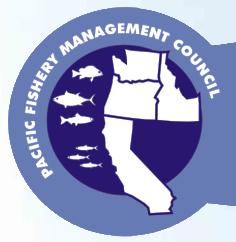 Most California fisheries still closed; seasons in north improved over last year
Most California fisheries still closed; seasons in north improved over last year
By Pacific Fishery Management Council,
MILLBRAE, Ca – For the second year in a row, the Pacific Fishery Management Council today closed commercial and most recreational salmon fisheries off the coast of California in response to the collapse of Sacramento River fall Chinook. The recommendation will be forwarded to the National Marine Fisheries Service for approval by May 1, 2009. In contrast, fisheries north of Cape Falcon, Oregon (near Nehalem Bay) will be better than they were last year, with much greater coho opportunity and similar Chinook opportunity.
Seasons South of Cape Falcon
A very limited 10 day recreational season will be permitted in California north of Cape Mendocino. Oregon Chinook seasons are also very restrictive, with a similar 10 day recreational season around Brookings. However, coho fishing will be allowed beginning in June and ending in August or September for the Oregon coast between Cape Falcon and the Oregon/California border.
Commercial Chinook fishing is prohibited in Oregon south of Cape Falcon, but a limited coho fishery will occur in September for the central Oregon coast between Cape Falcon and Humbug Mt.
The closures south of Cape Falcon, Oregon, are due to a continued decline in the number of Sacramento River fall Chinook returning to the river this year. The stock is the driver of commercial and recreational salmon fisheries off California and most of Oregon. The minimum conservation goal for Sacramento fall Chinook is 122,000 – 180,000 spawning adult salmon (this is the number of salmon needed to return to the river to maintain the health of the run). As recently as 2002, 775,000 adults returned to spawn. Last year, 66,200 fall run Chinook returned to the Sacramento. This year, about 122,100 fish are forecast to return—twice last year’s returns but still not enough to support commercial and recreational Chinook fisheries.
A second year of fishery closures in California and southern Oregon will be devastating to many small fishing communities. Fisheries off California and southern Oregon have been poor since 2005. In California and Oregon south of Cape Falcon, where Sacramento fish stocks have the biggest impact, the commercial and recreational salmon fishery had an average economic value of $103 million per year between 1979 and 2004. From 2001 to 2005, average economic impact to communities was $61 million ($40 million in the commercial fishery and $21 million in the recreational fishery).
Causes
In March, the National Marine Fisheries Service released a draft report, developed by over 20 scientists, on the collapse of Sacramento River fall Chinook in 2007-2008. The report identified several factors leading to the recent collapse, including poor ocean conditions, habitat degradation and water withdrawals, and changes in hatchery operations. The report concluded that while unfavorable ocean conditions likely led to poor survival of juvenile salmon as they entered the ocean environment in 2005 and 2006, the stock was more susceptible to those conditions because decades of freshwater habitat degradation and hatchery production have reduced the stock’s fitness and resiliency. The report also noted that the hatchery net-pen acclimation program was suspended in 2006, which contributed to poor survival of fish returning in 2008. In addition, while ocean conditions off Central California improved somewhat in 2007 the drought that year resulted in low numbers of juvenile salmon leaving the freshwater environment, and expectations for 2009 returns were not optimistic.
Seasons North of Cape Falcon
North of Cape Falcon, seasons are generally similar in structure to recent years, although coho quotas are substantially higher than in 2008, reflecting the increased abundance of both hatchery and natural coho stocks. Chinook quotas are similar to 2008.
Process
The Council reached this decision after several weeks spent reviewing three season options. The review process included input by federal and state fishery scientists, fishing industry members, public testimony, and three public hearings in coastal communities. The Council received additional scientific information and took public testimony before taking final action. The decision will be forwarded to the National Marine Fisheries Service for approval and implementation into federal regulations.
In addition, the coastal states will decide on compatible freshwater fishery regulations at their respective Commission hearings.
Press Packet and Briefing Materials Available
A press packet with contacts, background information, a map of affected areas, and acronyms is available on the Council website at the link below.
Council Role
The Pacific Fishery Management Council is one of eight regional fishery management councils established by the Magnuson Fishery Conservation and Management Act of 1976 for the purpose of managing fisheries 3-200 miles offshore of the United States of America coastline.
The Pacific Council recommends management measures for fisheries off the
coasts of California, Oregon, and Washington.
### On the Web
Pacific Fishery Management Council: http://www.pcouncil.org
Council-adopted 2009 ocean salmon management measures: http://www.pcouncil.org/salmon/salcurr.html#saloptions09
Geographical points used in salmon management: http://www.pcouncil.org/facts/geosalmon.pdf
Definition of terms used in salmon management: http://www.pcouncil.org/newsreleases/salmon_packet/Common_Terms.pdf
Online press packet: http://www.pcouncil.org/newsreleases/sal_presspacket2009.html
Disclaimer: Articles featured on Oregon Report are the creation, responsibility and opinion of the authoring individual or organization which is featured at the top of every article.


